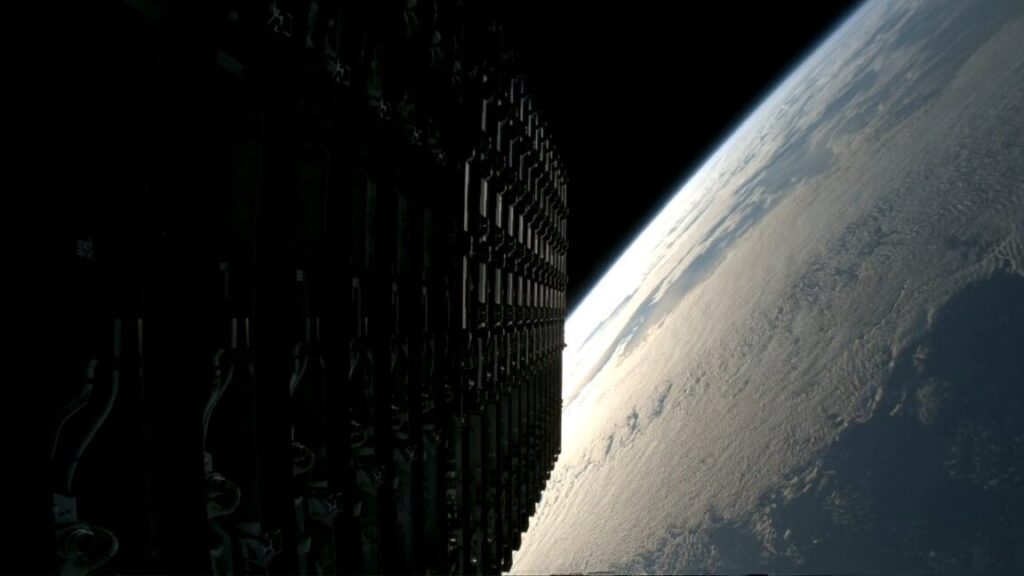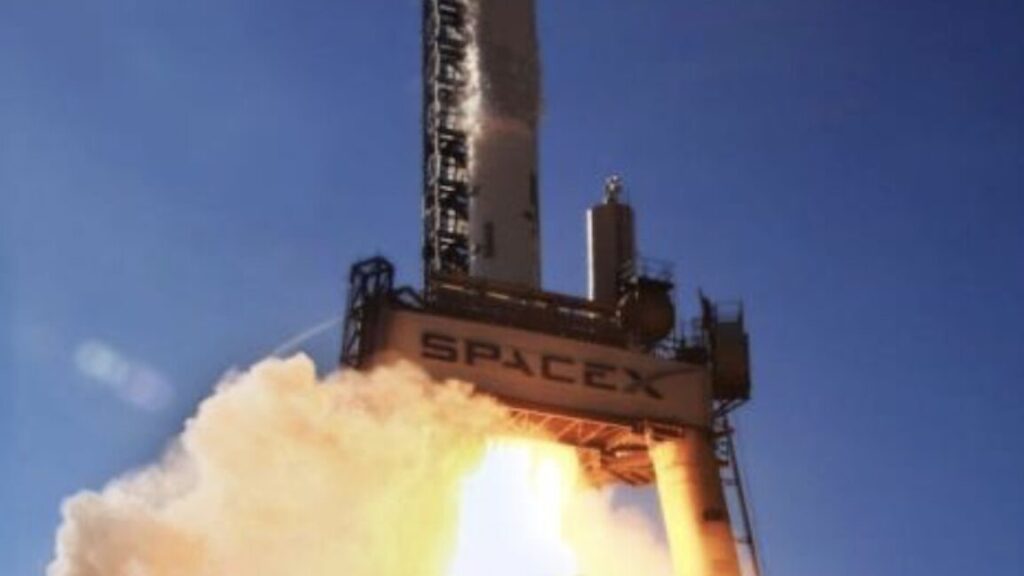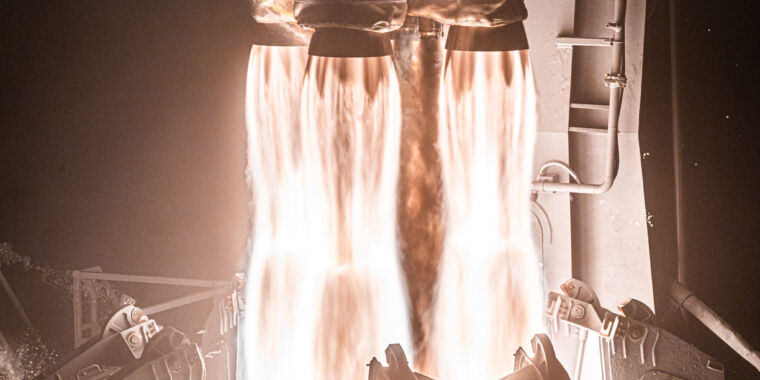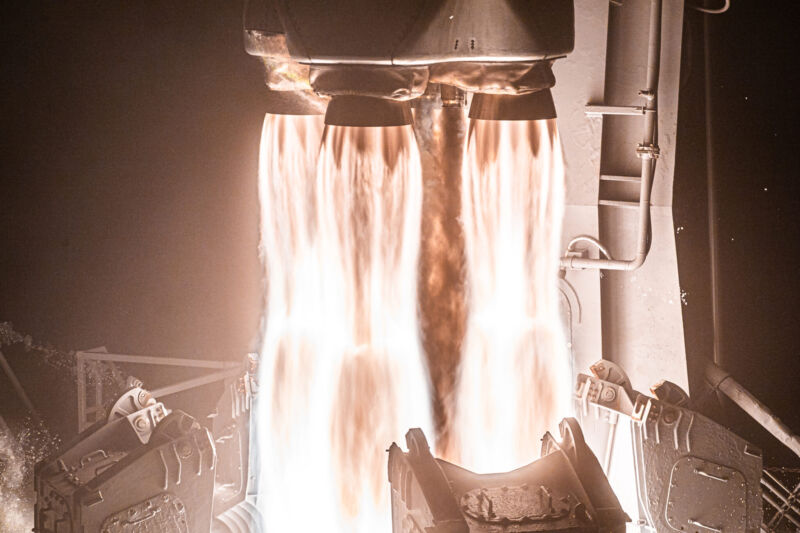Rocket Report: Another hiccup with SpaceX upper stage; Japan’s H3 starts strong
Vast’s schedule for deploying a mini-space station in low-Earth orbit was always ambitious.
A stack of 21 Starlink Internet satellites arrives in orbit Tuesday following launch on a Falcon 9 rocket. Credit: SpaceX
Welcome to Edition 7.30 of the Rocket Report! The US government relies on SpaceX for a lot of missions. These include launching national security satellites, putting astronauts on the Moon, and global broadband communications. But there are hurdles—technical and, increasingly, political—on the road ahead. To put it generously, Elon Musk, without whom much of what SpaceX does wouldn’t be possible, is one of the most divisive figures in American life today.
Now, a Democratic lawmaker in Congress has introduced a bill that would end federal contracts for special government employees (like Musk), citing conflict-of-interest concerns. The bill will go nowhere with Republicans in control of Congress, but it is enough to make me pause and think. When the Trump era passes and a new administration takes the White House, how will they view Musk? Will there be an appetite to reduce the government’s reliance on SpaceX? To answer this question, you must first ask if the government will even have a choice. What if, as is the case in many areas today, there’s no viable replacement for the services offered by SpaceX?
As always, we welcome reader submissions. If you don’t want to miss an issue, please subscribe using the box below (the form will not appear on AMP-enabled versions of the site). Each report will include information on small-, medium-, and heavy-lift rockets as well as a quick look ahead at the next three launches on the calendar.

Blue Origin flight focuses on lunar research. For the first time, Jeff Bezos’ Blue Origin space venture has put its New Shepard suborbital rocket ship through a couple of minutes’ worth of Moon-level gravity, GeekWire reports. The uncrewed mission, known as NS-29, sent 30 research payloads on a 10-minute trip from Blue Origin’s Launch Site One in West Texas. For this trip, the crew capsule was spun up to 11 revolutions per minute, as opposed to the typical half-revolution per minute. The resulting centrifugal force was equivalent to one-sixth of Earth’s gravity, which is what would be felt on the Moon.
Gee, that’s cool … The experiments aboard Blue Origin’s space capsule examined how to process lunar soil to extract resources and how to manufacture solar cells on the Moon for Blue Origin’s Blue Alchemist project. Another investigated how moondust gets electrically charged and levitated when exposed to ultraviolet light. These types of experiments in partial gravity can be done on parabolic airplane flights, but those only provide a few seconds of the right conditions to simulate the Moon’s gravity. (submitted by EllPeaTea)
Orbex announces two-launch deal with D-Orbit. UK-based rocket builder Orbex announced Monday that it has signed a two-launch deal with Italian in-orbit logistics provider D-Orbit, European Spaceflight reports. The deal includes capacity aboard two launches on Orbex’s Prime rocket over the next three years. D-Orbit aggregates small payloads on rideshare missions (primarily on SpaceX rockets so far) and has an orbital transfer vehicle for ferrying satellites to different altitudes after separation from a launch vehicle. Orbex’s Prime rocket is sized for the small satellite industry, and the company aims to debut it later this year.
Thanks to fresh funding? … Orbex has provided only sparse updates on its progress toward launching the Prime rocket. What we do know is that Orbex suspended plans to develop a spaceport in Scotland to focus its resources on the Prime rocket itself. Despite little evidence of any significant accomplishments, Orbex last month secured a $25 million investment from the UK government. The timing of the launch agreement with D-Orbit begs the question of whether the UK government’s backing helped seal the deal. As Andrew Parsonson of European Spaceflight writes: “Is this a clear indication of how important strong institutional backing is for the growth of privately developed launch systems in Europe?” (submitted by EllPeaTea)
The easiest way to keep up with Eric Berger’s and Stephen Clark’s reporting on all things space is to sign up for our newsletter. We’ll collect their stories and deliver them straight to your inbox.

Falcon 9’s upper stage misfires again. The second stage of a SpaceX Falcon 9 rocket remained in orbit following a launch Saturday from Vandenberg Space Force Base, California. The rocket successfully deployed a new batch of Starlink Internet satellites but was supposed to reignite its engine for a braking maneuver to head for a destructive reentry over the Pacific Ocean. While airspace warning notices from the FAA showed a reentry zone over the eastern Pacific Ocean, publicly available US military tracking continued to show the upper stage in orbit this week. Sources also told Ars that SpaceX delayed two Falcon 9 launches this week by a day to allow time for engineers to evaluate the problem.
3 in 6 months … This is the third time since last July that the Falcon 9’s upper stage has encountered a problem in flight. On one occasion, the upper stage failed to reach its targeted orbit, leading to the destruction of 20 Starlink satellites. Then, an upper stage misfired during a deorbit burn after an otherwise successful launch in September, causing debris to fall outside of the pre-approved danger area. After both events, the FAA briefly grounded the Falcon 9 rocket while SpaceX conducted an investigation. This time, an FAA spokesperson said the agency won’t require an investigation. “All flight events occurred within the scope of SpaceX’s licensed activities,” the spokesperson told Ars.
Vast tests hardware for commercial space station. Vast Space has started testing a qualification model of its first commercial space station but has pushed back the launch of that station into 2026, Space News reports. In an announcement Thursday, Vast said it completed a proof test of the primary structure of a test version of its Haven-1 space station habitat at a facility in Mojave, California. During the testing, Vast pumped up the pressure inside the structure to 1.8 times its normal level and conducted a leak test. “On the first try we passed that critical test,” Max Haot, chief executive of Vast, told Space News.
Not this year … It’s encouraging to see Vast making tangible progress in developing its commercial space station. The privately held company is one of several seeking to develop a commercial outpost in low-Earth orbit to replace the International Space Station after its scheduled retirement in 2030. NASA is providing funding to two industrial teams led by Blue Origin and Voyager Space, which are working on different space station concepts. But so far, Vast’s work has been funded primarily through private capital. The launch of the Haven-1 outpost, which Vast previously said could happen this year, is now scheduled no earlier than May 2026. The spacecraft will launch in one piece on a Falcon 9 rocket, and the first astronaut crew to visit Haven-1 could launch a month later. Haven-1 is a pathfinder for a larger commercial station called Haven-2, which Vast intends to propose to NASA. (submitted by EllPeaTea)
H3 deploys Japanese navigation satellite. Japan successfully launched a flagship H3 rocket Sunday and put into orbit a Quasi-Zenith Satellite (QZS), aiming to improve the accuracy of global positioning data for various applications, Kyodo News reports. After separation from the H3 rocket, the Michibiki 6 satellite will climb into geostationary orbit, where it will supplement navigation signals from GPS satellites to provide more accurate positioning data to users in Japan and surrounding regions, particularly in mountainous terrain and amid high-rise buildings in large cities. The new satellite joins a network of four QZS spacecraft launched by Japan beginning in 2010. Two more Quasi-Zenith Satellites are under construction, and Japan’s government is expected to begin development of an additional four regional navigation satellites this year.
A good start … After a failed inaugural flight in 2023, Japan’s new H3 rocket has reeled off four consecutive successful launches in less than a year. This may not sound like a lot, but the H3 has achieved its first four successful flights faster than any other rocket since 2000. SpaceX’s Falcon 9 rocket completed its first four successful flights in a little more than two years, and United Launch Alliance’s Atlas V logged its fourth flight in a similar timeframe. More than 14 months elapsed between the first and fourth successful flight of Rocket Lab’s Electron rocket. The H3 is an expendable rocket with no roadmap to reusability, so its service life and commercial potential are likely limited. But the rocket is shaping up to provide reliable access to space for Japan’s space agency and military, while some of its peers in Europe and the United States struggle to ramp up to a steady launch cadence. (submitted by EllPeaTea)

Europe really doesn’t like relying on Elon Musk. Europe’s space industry has struggled to keep up with SpaceX for a decade. The writing was on the wall when SpaceX landed a Falcon 9 booster for the first time. Now, European officials are wary of becoming too reliant on SpaceX, and there’s broad agreement on the continent that Europe should have the capability to launch its own satellites. In this way, access to space is a strategic imperative for Europe. The problem is, Europe’s new Ariane 6 rocket is just not competitive with SpaceX’s Falcon 9, and there’s no concrete plan to counter SpaceX’s dominance.
So here’s another terrible idea … Airbus, Europe’s largest aerospace contractor with a 50 percent stake in the Ariane 6 program, has enlisted Goldman Sachs for advice on how to forge a new European space and satellite company to better compete with SpaceX. France-based Thales and the Italian company Leonardo are part of the talks, with Bank of America also advising on the initiative. The idea that some bankers from Goldman and Bank of America will go into the guts of some of Europe’s largest institutional space companies and emerge with a lean, competitive entity seems far-fetched, to put it mildly, Ars reports.
The FAA still has some bite. We’re now three weeks removed from the most recent test flight of SpaceX’s Starship rocket, which ended with the failure of the vehicle’s upper stage in the final moments of its launch sequence. The accident rained debris over the Atlantic Ocean and the Turks and Caicos Islands. Unsurprisingly, the Federal Aviation Administration grounded Starship and ordered an investigation into the accident on the day after the launch. This decision came three days before the inauguration of President Donald Trump, who counts Musk as one of his top allies. So far, the FAA hasn’t budged on its requirement for an investigation, an agency spokesperson told Ars.
Debris field … In the hours and days after the failed Starship launch, residents and tourists in the Turks and Caicos shared images of debris scattered across the islands and washing up onshore. The good news is there were no injuries or reports of significant damage from the wreckage, but the FAA confirmed one report of minor damage to a vehicle located in South Caicos. It’s rare for debris from US rockets to fall over land during a launch. This would typically only happen if a launch failed at certain parts of the flight. Before now, there has been no public record of any claims of third-party property damage in the era of commercial spaceflight.
DOD eager to reap the benefits of Starship. A Defense Department unit is examining how SpaceX’s Starship vehicle could be used to support a broader architecture of in-space refueling, Space News reports. A senior adviser at the Defense Innovation Unit (DIU) said SpaceX approached the agency about how Starship’s refueling architecture could be used by the wider space industry. The plan for Starship is to transfer cryogenic propellants between tankers, depots, and ships heading to the Moon, Mars, or other deep-space destinations.
Few details available … US military officials have expressed interest in orbital refueling to support in-space mobility, where ground controllers have the freedom to maneuver national security satellites between different orbits without worrying about running out of propellant. For several years, Space Force commanders and Pentagon officials have touted the importance of in-space mobility, or dynamic space operations, in a new era of orbital warfare. However, there are reports that the Space Force has considered zeroing out a budget line item for space mobility in its upcoming fiscal year 2026 budget request.
A small step toward a fully reusable European rocket. The French space agency CNES has issued a call for proposals to develop a reusable upper stage for a heavy-lift rocket, European Spaceflight reports. This project is named DEMESURE (DEMonstration Étage SUpérieur REutilisable / Reusable Upper Stage Demonstration), and it marks one of Europe’s first steps in developing a fully reusable rocket. That’s all good, but there’s a sense of tentativeness in this announcement. The current call for proposals will only cover the earliest phases of development, such as a requirements evaluation, cost estimation review, and a feasibility meeting. A future call will deal with the design and fabrication of a “reduced scale” upper stage, followed by a demonstration phase with a test flight, recovery, and reuse of the vehicle. CNES’s vision is to field a fully reusable rocket as a successor to the single-use Ariane 6.
Toes in the water … If you’re looking for reasons to be skeptical about Project DEMESURE, look no further than the Themis program, which aims to demonstrate the recovery and reuse of a booster stage akin to SpaceX’s Falcon 9. Themis originated in a partnership between CNES and European industry in 2019, then ESA took over the project in 2020. Five years later, the Themis demonstrator still hasn’t flown. After some initial low-altitude hops, Themis is supposed to launch on a high-altitude test flight and maneuver through the entire flight profile of a reusable booster, from liftoff to a vertical propulsive landing. As we’ve seen with SpaceX, recovering an orbital-class upper stage is a lot harder than landing the booster. An optimistic view of this announcement is that anything worth doing requires taking a first step, and that’s what CNES has done here. (submitted by EllPeaTea)
Next three launches
Feb. 7: Falcon 9 | Starlink 12-9 | Cape Canaveral Space Force Station, Florida | 18: 52 UTC
Feb. 8: Electron | IoT 4 You and Me | Māhia Peninsula, New Zealand | 20: 43 UTC
Feb. 10: Falcon 9 | Starlink 11-10 | Vandenberg Space Force Base, California | 00: 03 UTC

Rocket Report: Another hiccup with SpaceX upper stage; Japan’s H3 starts strong Read More »




